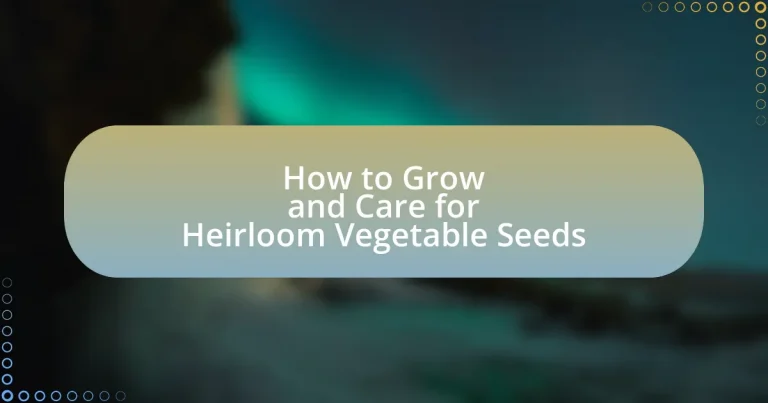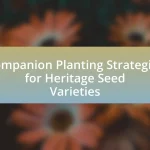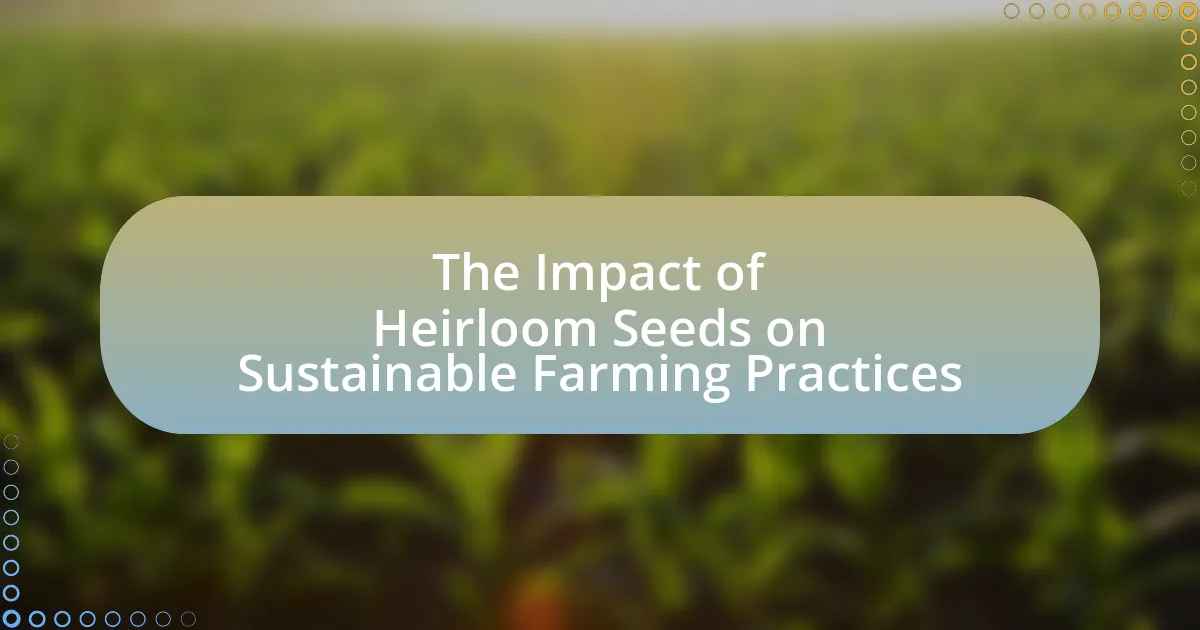Heirloom vegetable seeds are open-pollinated seeds that have been preserved for at least 50 years, valued for their unique flavors, colors, and genetic diversity. This article provides a comprehensive guide on how to grow and care for heirloom vegetable seeds, detailing their differences from hybrid seeds, the benefits of growing them, and the importance of seed saving for biodiversity. Key topics include ideal growing conditions, pest management strategies, and best practices for transplanting and caring for heirloom plants, ensuring gardeners can successfully cultivate these traditional varieties while promoting sustainable agriculture.
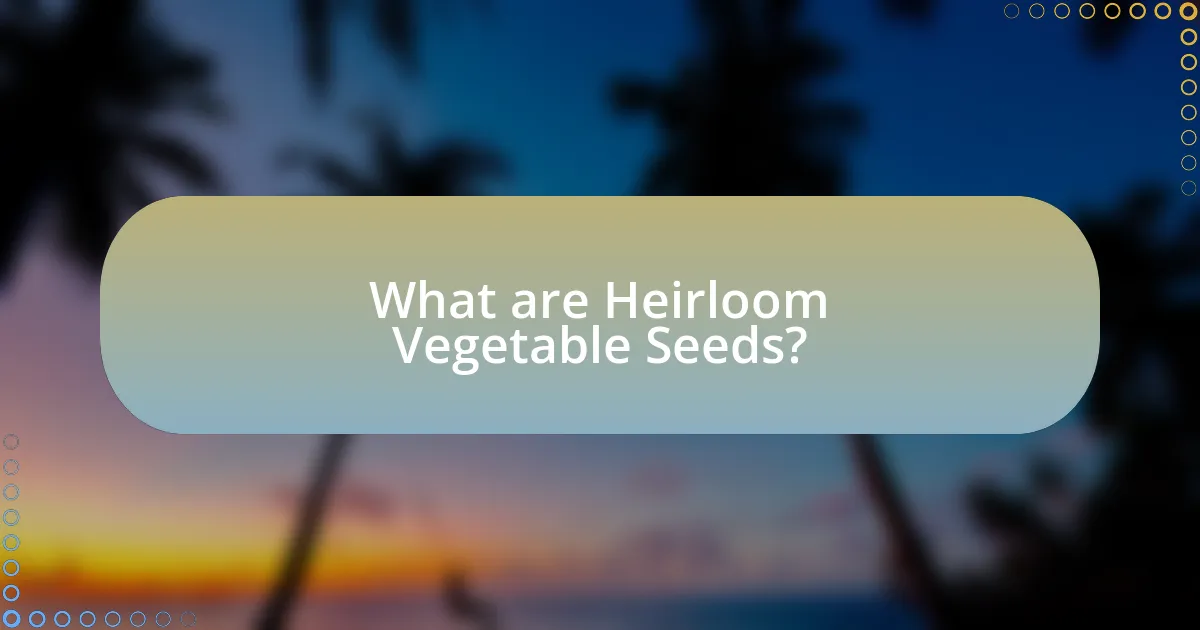
What are Heirloom Vegetable Seeds?
Heirloom vegetable seeds are seeds that have been passed down through generations, typically for at least 50 years, and are valued for their unique flavors, colors, and characteristics. These seeds are open-pollinated, meaning they can be saved and replanted, allowing gardeners to cultivate plants that maintain the same traits as the parent plants. The preservation of heirloom seeds contributes to biodiversity and helps maintain traditional agricultural practices, as they often represent specific regional varieties that may not be available in commercial seed markets.
How do heirloom vegetable seeds differ from hybrid seeds?
Heirloom vegetable seeds differ from hybrid seeds primarily in their genetic makeup and breeding practices. Heirloom seeds are open-pollinated varieties that have been passed down through generations, often for 50 years or more, and they retain stable traits, allowing them to be saved and replanted year after year. In contrast, hybrid seeds are created through controlled cross-pollination between two different parent plants, resulting in offspring that may exhibit desirable traits but often do not produce seeds that will grow true to type in subsequent generations. This distinction is significant as heirloom seeds promote biodiversity and preserve unique flavors and characteristics, while hybrid seeds are typically bred for uniformity and higher yields.
What defines an heirloom seed?
An heirloom seed is defined as a seed variety that has been passed down through generations, typically for at least 50 years, and is open-pollinated, meaning it can reproduce itself naturally. These seeds are valued for their genetic diversity, unique flavors, and historical significance, often representing specific regions or cultures. The preservation of heirloom seeds is crucial for maintaining biodiversity in agriculture, as they contribute to the resilience of food systems and provide a rich source of heritage crops.
Why are heirloom seeds considered more sustainable?
Heirloom seeds are considered more sustainable because they are open-pollinated varieties that have been passed down through generations, allowing for genetic diversity and adaptability to local growing conditions. This genetic diversity enhances resilience against pests and diseases, reducing the need for chemical inputs. Additionally, heirloom seeds can be saved and replanted year after year, promoting self-sufficiency and reducing reliance on commercial seed production, which often involves hybrid varieties that cannot be saved. Studies show that maintaining diverse seed varieties contributes to ecosystem stability and food security, further validating the sustainability of heirloom seeds.
What are the benefits of growing heirloom vegetable seeds?
Growing heirloom vegetable seeds offers numerous benefits, including enhanced flavor, biodiversity, and adaptability to local growing conditions. Heirloom varieties are known for their superior taste compared to many commercial hybrids, which often prioritize shelf life over flavor. Additionally, these seeds contribute to agricultural biodiversity, preserving unique genetic traits that can be crucial for resilience against pests and diseases. Research indicates that heirloom plants often adapt better to specific climates and soils, leading to improved yields in local environments. Furthermore, growing heirloom seeds supports sustainable agriculture practices, as they can be saved and replanted year after year, reducing dependence on commercial seed sources.
How do heirloom seeds contribute to biodiversity?
Heirloom seeds contribute to biodiversity by preserving a wide variety of plant genetics that are adapted to local environments and agricultural practices. These seeds are often open-pollinated and have been passed down through generations, maintaining unique traits that can enhance resilience against pests, diseases, and climate variations. For example, heirloom varieties can include thousands of different types of tomatoes, each with distinct flavors, colors, and growth habits, which supports a diverse ecosystem. This genetic diversity is crucial for food security and sustainable agriculture, as it allows for a broader range of crops that can thrive under changing environmental conditions.
What flavors and qualities do heirloom vegetables offer?
Heirloom vegetables offer a diverse range of flavors and qualities that are often more intense and complex than those of hybrid varieties. These vegetables are typically open-pollinated, meaning they can be saved and replanted, which contributes to their unique taste profiles developed over generations. For example, heirloom tomatoes are known for their rich, sweet, and sometimes tangy flavors, which can vary significantly between varieties, such as the Brandywine or Cherokee Purple. Additionally, heirloom vegetables often exhibit superior nutritional qualities, including higher levels of antioxidants and vitamins, as evidenced by studies showing that heirloom varieties can contain more phytonutrients compared to commercial hybrids. This combination of distinctive flavors and enhanced nutritional benefits makes heirloom vegetables highly valued among chefs and home gardeners alike.
Why is it important to save heirloom seeds?
Saving heirloom seeds is important because it preserves genetic diversity and ensures the availability of unique plant varieties for future generations. Heirloom seeds are open-pollinated, meaning they can be saved and replanted, which promotes sustainable agriculture and resilience against pests and diseases. According to the Seed Savers Exchange, over 90% of the vegetable varieties available in 1900 are now extinct, highlighting the critical need to maintain these seeds to protect biodiversity and food security.
How does seed saving impact future generations?
Seed saving positively impacts future generations by preserving genetic diversity and promoting sustainable agriculture. By saving seeds from heirloom varieties, individuals ensure that unique traits, such as flavor, resilience, and adaptability to local conditions, are maintained. This practice contributes to biodiversity, which is crucial for food security, as diverse crops are more resilient to pests, diseases, and climate change. Historical evidence shows that traditional seed saving has allowed communities to adapt their crops over centuries, enhancing their ability to thrive in varying environments. For instance, the Seed Savers Exchange has documented thousands of heirloom varieties, emphasizing the importance of preserving these seeds for future agricultural resilience.
What techniques are used for saving heirloom seeds?
Techniques for saving heirloom seeds include proper selection, drying, and storage. Selecting seeds from healthy, mature plants ensures genetic integrity; for example, seeds should be harvested from the best specimens to maintain desirable traits. After harvesting, seeds must be dried thoroughly to prevent mold and decay, typically requiring a period of air drying in a cool, dark place. Finally, storing seeds in airtight containers in a cool, dark environment prolongs their viability, with optimal conditions being around 40°F and low humidity. These methods are supported by agricultural practices that emphasize seed preservation for future planting.
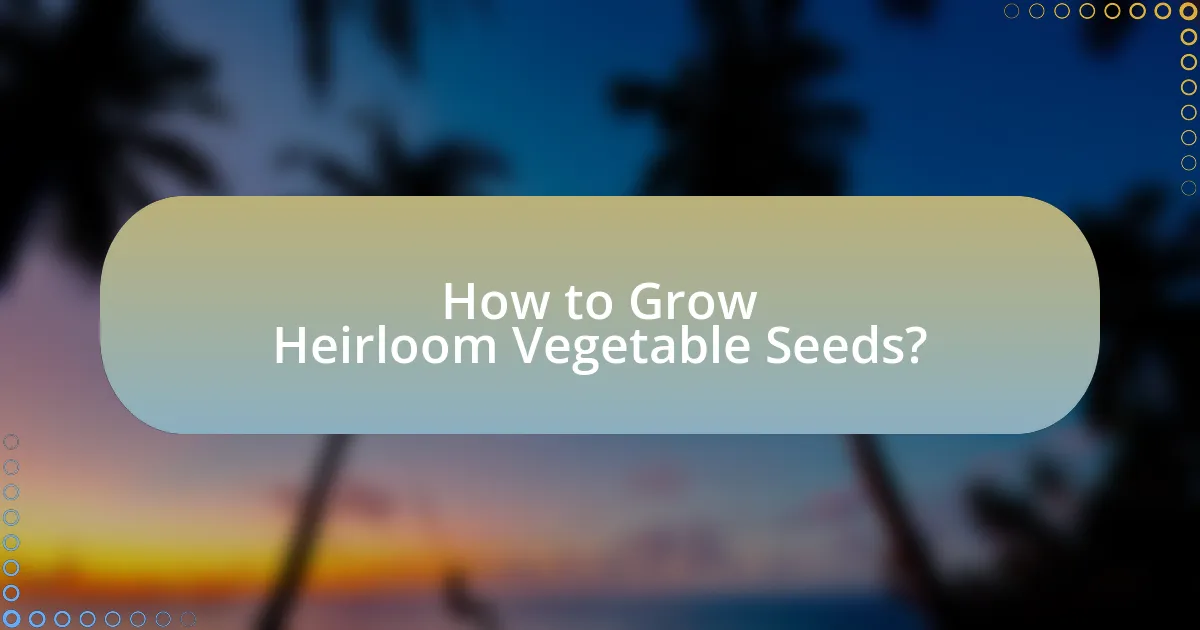
How to Grow Heirloom Vegetable Seeds?
To grow heirloom vegetable seeds, start by selecting high-quality seeds from a reputable source, ensuring they are suited to your climate and soil conditions. Prepare the soil by tilling and enriching it with organic matter, such as compost, to improve fertility and drainage. Plant the seeds at the recommended depth and spacing, typically indicated on the seed packet, and water them gently to keep the soil consistently moist but not waterlogged. Heirloom varieties often require specific care, including regular weeding and monitoring for pests, which can be managed through organic methods like companion planting or natural insect repellents. According to the USDA, heirloom seeds are defined as open-pollinated varieties that have been preserved for at least 50 years, ensuring genetic diversity and resilience in your garden.
What are the best practices for starting heirloom seeds indoors?
The best practices for starting heirloom seeds indoors include selecting high-quality seeds, using sterile seed-starting mix, providing adequate light, maintaining optimal temperature, and ensuring proper moisture levels. High-quality seeds ensure better germination rates and healthier plants. A sterile seed-starting mix prevents diseases that can affect seedlings. Adequate light, ideally from grow lights or a sunny window, supports strong growth, while maintaining a temperature between 65°F and 75°F promotes germination. Lastly, keeping the soil consistently moist but not waterlogged is crucial for seedling development. These practices collectively enhance the success rate of growing heirloom plants indoors.
How do you prepare seed trays for planting?
To prepare seed trays for planting, first, select a clean seed tray with drainage holes to prevent waterlogging. Fill the tray with a high-quality seed-starting mix, ensuring it is moist but not soggy. Firm the soil gently to eliminate air pockets, then level the surface. After that, sow the seeds according to the recommended depth for each type, typically two to three times the seed’s diameter. Finally, label the trays with the seed variety and date of planting for easy identification. This method ensures optimal conditions for seed germination and growth, as using a sterile mix reduces disease risk and proper moisture levels support seedling development.
What conditions are ideal for germination?
Ideal conditions for germination include warmth, moisture, and oxygen. Seeds typically require a temperature range of 65 to 75 degrees Fahrenheit for optimal germination. Moisture is essential as it activates enzymes that begin the growth process, while oxygen is necessary for cellular respiration. Research indicates that seeds absorb water, swell, and break dormancy when these conditions are met, leading to successful sprouting.
How should heirloom seeds be transplanted outdoors?
Heirloom seeds should be transplanted outdoors after the last frost date when seedlings are 4 to 6 weeks old. To ensure successful transplantation, prepare the garden bed by loosening the soil and adding organic matter. When transplanting, dig holes that are slightly larger than the root ball of each seedling, place the seedlings in the holes, and cover the roots with soil, ensuring the plants are at the same depth as they were in their containers. Water the seedlings thoroughly after transplanting to help them establish in their new environment. This method is effective because it minimizes transplant shock and promotes healthy growth.
What is the best time to transplant heirloom seedlings?
The best time to transplant heirloom seedlings is after the last frost date in your area, typically in spring. This timing ensures that the seedlings are moved to their permanent outdoor location when temperatures are consistently warm enough for their growth. For example, in USDA hardiness zones, the last frost date can range from late March to early June, depending on the region. Transplanting at this time helps to minimize stress on the plants and promotes healthy establishment in the garden.
How do you harden off seedlings before transplanting?
To harden off seedlings before transplanting, gradually expose them to outdoor conditions over a period of 7 to 14 days. Start by placing seedlings in a sheltered location for a few hours each day, gradually increasing their time outside and exposure to sunlight, wind, and temperature fluctuations. This process helps seedlings acclimate to their new environment, reducing transplant shock. Research indicates that seedlings that undergo proper hardening off have a higher survival rate and better growth post-transplanting, as they adapt to the stressors of outdoor conditions effectively.
What are the key factors in caring for heirloom vegetable plants?
The key factors in caring for heirloom vegetable plants include proper soil preparation, adequate watering, pest management, and appropriate sunlight exposure. Soil should be rich in organic matter and well-draining to support healthy growth. Heirloom vegetables typically require consistent moisture, so regular watering is essential, especially during dry spells. Effective pest management strategies, such as crop rotation and the use of natural predators, help protect these plants from common pests. Additionally, heirloom vegetables thrive in full sunlight, requiring at least six to eight hours of direct sunlight daily to produce optimal yields.
How do you ensure proper watering and drainage?
To ensure proper watering and drainage for heirloom vegetable seeds, implement a consistent watering schedule while utilizing well-draining soil. Consistent watering, typically once a week, helps maintain moisture without over-saturating the soil. Well-draining soil, often achieved by mixing organic matter like compost with garden soil, prevents waterlogging, which can lead to root rot. Research indicates that plants thrive best in soil that retains moisture yet allows excess water to escape, promoting healthy root development.
What nutrients do heirloom vegetables require?
Heirloom vegetables require essential nutrients such as nitrogen, phosphorus, potassium, calcium, magnesium, and sulfur for optimal growth. Nitrogen promotes leafy growth, phosphorus supports root development and flowering, while potassium enhances overall plant health and disease resistance. Calcium is crucial for cell wall structure, magnesium aids in photosynthesis, and sulfur is important for protein synthesis. These nutrients can be supplied through organic matter, compost, and balanced fertilizers, ensuring heirloom vegetables thrive in diverse soil conditions.

What are common challenges in growing heirloom vegetable seeds?
Common challenges in growing heirloom vegetable seeds include susceptibility to pests and diseases, inconsistent germination rates, and the need for specific growing conditions. Heirloom varieties often lack the disease resistance found in hybrid seeds, making them more vulnerable to issues like blight and aphids. Additionally, heirloom seeds may not germinate uniformly due to genetic variability, leading to uneven plant growth. Finally, many heirloom vegetables require particular soil types, climate conditions, and care practices, which can complicate their cultivation in diverse environments.
How can pests and diseases affect heirloom vegetables?
Pests and diseases can significantly reduce the yield and quality of heirloom vegetables. These plants, often more susceptible due to their genetic diversity and lack of modern breeding for disease resistance, can experience stunted growth, reduced fruit production, and increased vulnerability to environmental stressors. For instance, aphids can transmit viral diseases, leading to yellowing leaves and poor plant health, while fungal infections like powdery mildew can cause leaf damage and hinder photosynthesis. Research indicates that heirloom varieties may lack the robust defenses found in hybrid counterparts, making them more prone to infestations and infections.
What are effective organic pest control methods?
Effective organic pest control methods include the use of beneficial insects, natural repellents, and cultural practices. Beneficial insects, such as ladybugs and lacewings, prey on harmful pests like aphids and caterpillars, thereby reducing their populations. Natural repellents, including neem oil and insecticidal soap, disrupt the life cycles of pests without harming beneficial organisms. Cultural practices, such as crop rotation and companion planting, enhance plant health and deter pests by creating an unfavorable environment for them. These methods are supported by research indicating that integrated pest management strategies can significantly reduce pest populations while promoting ecological balance.
How do you identify and treat common diseases in heirloom plants?
To identify and treat common diseases in heirloom plants, first observe symptoms such as yellowing leaves, wilting, or unusual spots, which indicate potential issues like fungal infections or pests. For instance, powdery mildew appears as white spots on leaves, while blight can cause dark, water-soaked spots. Treatment involves removing affected plant parts, improving air circulation, and applying organic fungicides or insecticidal soaps as needed. Research shows that early detection and intervention can significantly reduce crop loss, with studies indicating that timely fungicide application can improve yield by up to 30%.
What environmental factors can impact heirloom vegetable growth?
Heirloom vegetable growth is significantly impacted by environmental factors such as soil quality, temperature, humidity, and sunlight exposure. Soil quality affects nutrient availability and drainage, which are crucial for healthy plant development. For instance, heirloom varieties often thrive in well-drained, nutrient-rich soils with a pH between 6.0 and 7.0. Temperature plays a vital role, as most heirloom vegetables prefer specific ranges; for example, tomatoes flourish in temperatures between 70°F and 85°F. Humidity levels can influence disease susceptibility, with high humidity promoting fungal infections. Lastly, adequate sunlight, typically 6 to 8 hours daily, is essential for photosynthesis and overall plant vigor. These factors collectively determine the success of growing heirloom vegetables.
How does soil quality affect heirloom vegetables?
Soil quality significantly affects heirloom vegetables by influencing their growth, flavor, and nutritional content. High-quality soil, rich in organic matter and essential nutrients, promotes healthy root development and enhances the plants’ ability to absorb water and nutrients. Research indicates that heirloom varieties often have specific soil requirements; for instance, studies show that heirloom tomatoes thrive in well-drained, loamy soils with a pH between 6.0 and 6.8, which optimizes their flavor profile and yield. Additionally, soil health impacts the microbial ecosystem, which can enhance disease resistance and overall plant vigor, further validating the importance of maintaining high soil quality for successful heirloom vegetable cultivation.
What role does climate play in growing heirloom seeds?
Climate significantly influences the growth of heirloom seeds by determining the temperature, humidity, and seasonal patterns essential for germination and development. Heirloom seeds, which are open-pollinated varieties, often have specific climate adaptations that affect their growth cycles; for instance, some may thrive in cooler temperatures while others require warmer conditions. Research indicates that heirloom varieties can exhibit different yields and flavor profiles based on local climate conditions, as seen in studies where heirloom tomatoes grown in warmer climates produced higher sugar content compared to those in cooler areas. Thus, understanding the local climate is crucial for selecting the appropriate heirloom seeds to ensure optimal growth and harvest.
What are some tips for successful heirloom vegetable gardening?
Successful heirloom vegetable gardening requires selecting the right heirloom varieties, ensuring proper soil health, and practicing effective pest management. Choosing heirloom seeds that are well-suited to your local climate and soil conditions enhances growth and yield. Maintaining soil health through organic matter, such as compost, improves nutrient availability and promotes beneficial microorganisms. Implementing integrated pest management strategies, including crop rotation and companion planting, minimizes pest issues while preserving the ecosystem. These practices are supported by research indicating that heirloom varieties often exhibit greater resilience and adaptability, making them a sustainable choice for gardeners.
How can companion planting benefit heirloom vegetables?
Companion planting can significantly benefit heirloom vegetables by enhancing growth, improving pest control, and increasing biodiversity. For instance, planting marigolds alongside heirloom tomatoes can deter nematodes and other pests, leading to healthier plants and higher yields. Additionally, certain combinations, like basil with heirloom peppers, can improve flavor and growth rates due to complementary nutrient uptake. Research indicates that these practices can lead to a more resilient garden ecosystem, ultimately supporting the unique traits of heirloom varieties.
What are the best heirloom varieties for beginners?
The best heirloom varieties for beginners include ‘Brandywine’ tomatoes, ‘Kentucky Wonder’ beans, and ‘Lacinato’ kale. These varieties are known for their ease of growth, resilience, and high yield, making them ideal for novice gardeners. For instance, ‘Brandywine’ tomatoes are praised for their rich flavor and adaptability to various climates, while ‘Kentucky Wonder’ beans are vigorous and produce abundantly even in less-than-ideal soil conditions. ‘Lacinato’ kale is also forgiving and can thrive in cooler temperatures, providing a nutritious crop with minimal effort. These heirloom varieties not only offer a rewarding gardening experience but also contribute to biodiversity and the preservation of traditional plant genetics.
